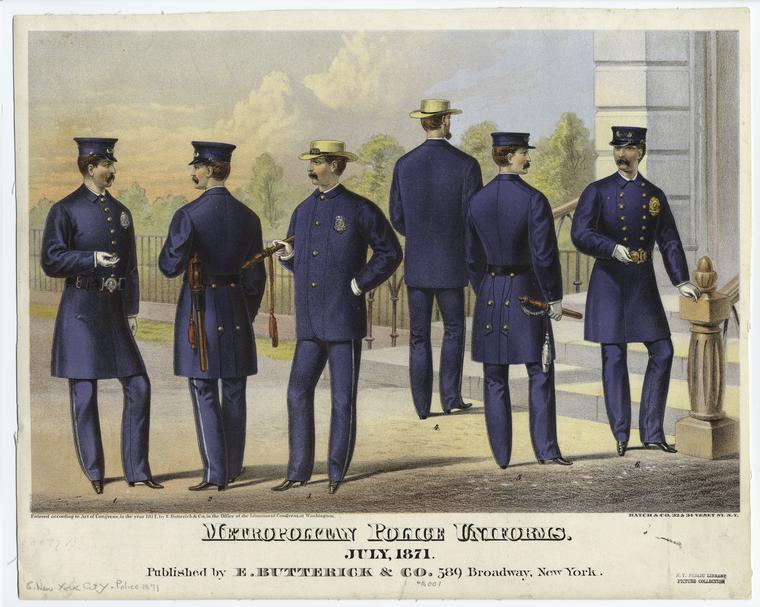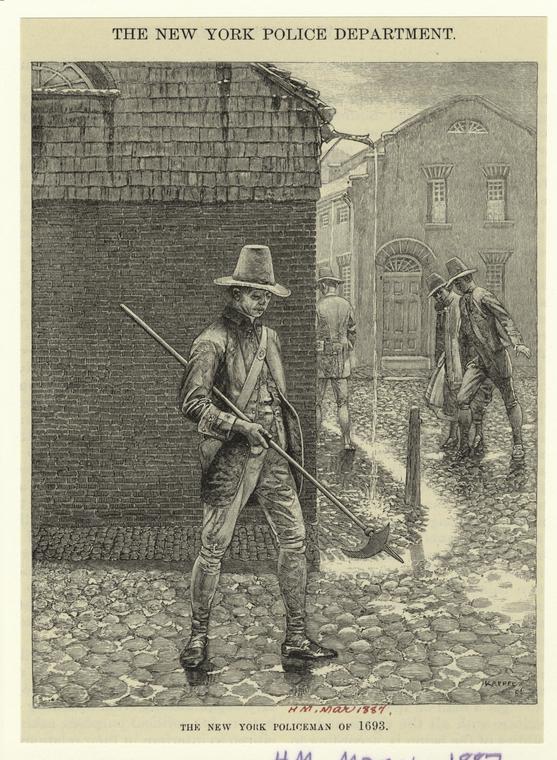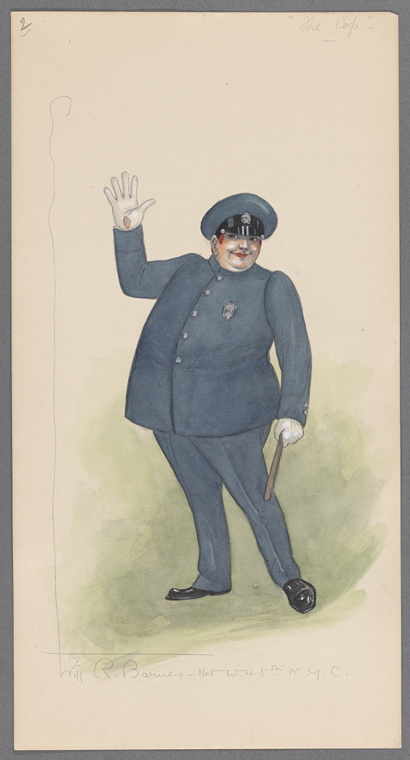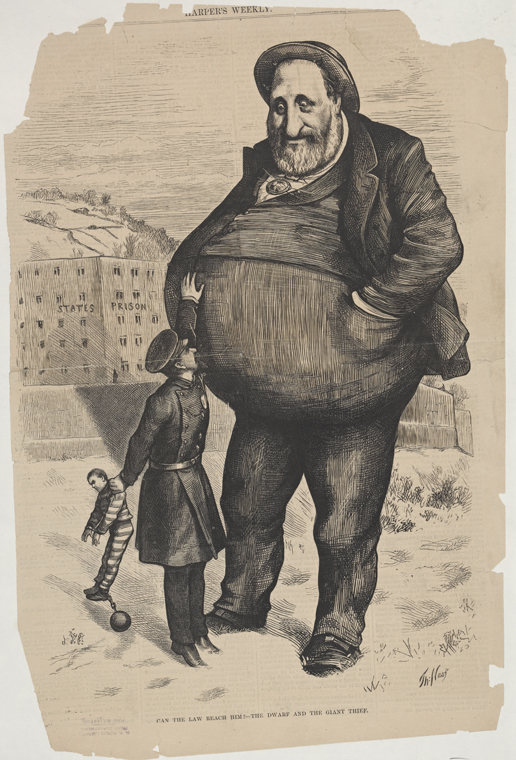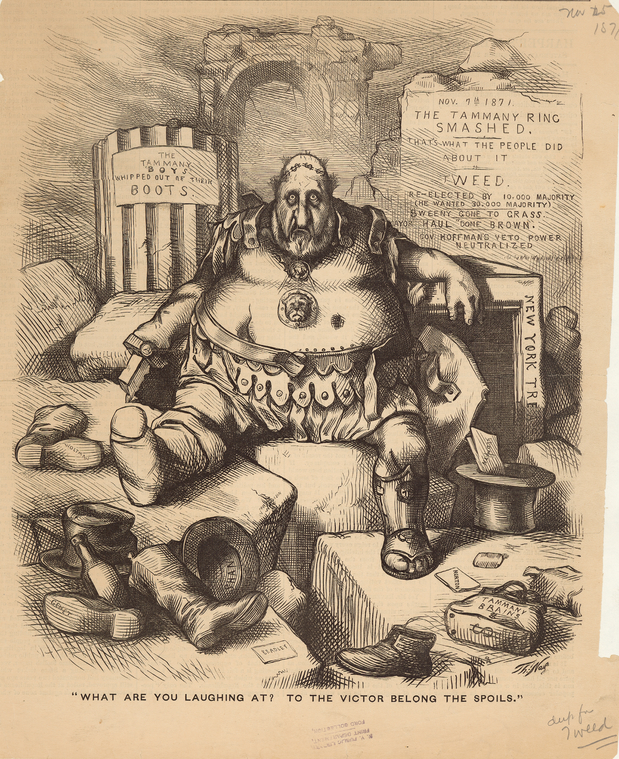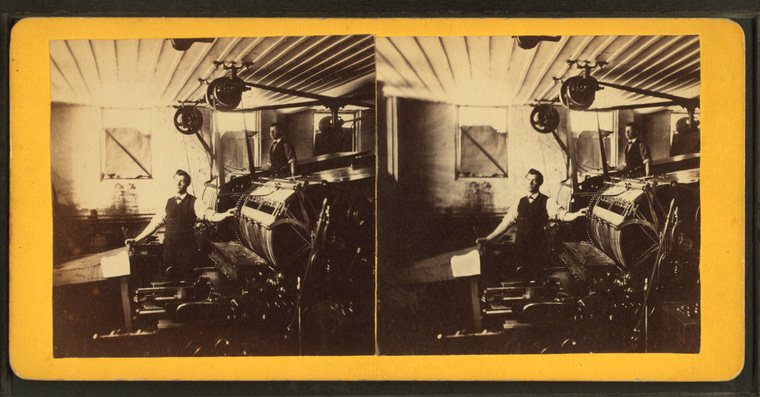Genealogy Tips: New York Cops in The City Record
Researchers who discover that an ancestor was employed as a New York City police officer will often ask librarians in the Milstein Division about where to find historical “police records.”
For the five boroughs, there really is no collection of historical “police records.”
Researchers can submit a Freedom of Information Act request with the New York City Police Department. In addition, the NYPD offers an online Verification of Crime / Lost Property Online Submission.
Otherwise, any smattering that was kept and saved resembles a hail of rocks launched from a Bowery window during the 1857 Dead Rabbits Riot across the records rooms and libraries of the Big Apple.
When city librarians and archivists were organizing the Municipal Reference Library in the 1920s, they found that, in 1914, "police department records prior to the consolidation of Greater New York… had been deemed expendable, removed from police headquarters, and sold to a paper mill, where they were ground into pulp; the destroyed records were from the years when Tammany Hall controlled appointments to the police department and required kickbacks in the form of campaign donations for jobs and promotions" (“Rebecca Rankin’s Campaign for a Municipal Archives 1920-1952” / Seaver).
If a researcher is looking for historical information about a crime, there are useful but limited research options, including a report in the newspaper or possibly a court record at the Municipal Archives or a trial transcript in the Special Collections at John Jay College of Criminal Justice.
If a researcher is looking for an individual who was in law enforcement, an alternate resource might be to research The City Record.

The City Record is a daily published account of how the government of New York City spends money.
Money is the soul, spirit, bane, ethos, virus, mythos, psyche, and psychosis of the City That Never Sleeps.
The City Record is captioned “The Official Journal of the City of New York,” as if it contained the secret and innermost thoughts about what has always been the top priority and basest obsession of The Big Apple (which nickname was derived from 1920s jazz and turf slang for money).
The focus of this guide is the New York Police Department, but The City Record can similarly be used to research any individual who was once employed by the city of New York. In addition, The City Record acts as a highly detailed resource for historical information on how the municipal government operated, featuring contract bids, address directories, rules and regulations, notices of hearings, auctions, codes, and city planning maps. For example, to know how the Board of Health dealt with public waste in 1873, see the section on "Night Scavenging."

Research
The City Record is available in the following formats for the following date ranges:
- Print (1873—Sept 1909) (2001—Jun 2010)
- Microfilm (Oct 1909—2000)
- Digitized (1873—1947 | 2008—current)
The print editions are bound and oversized. NYPL holdings of print and microfilm are detailed in the library catalog record. Access to these requires a request from off-site storage.
The most recent holding at NYPL is Jan-Jun 2010 located at the Science Industry and Business Library.
The early digitized copies are freely searchable at HathiTrust and also at the NYU Polytechnic Institute:
- The City Record (1873-1947) digitized and arranged by date at the NYU Tandon School of Engineering.
- The City Record (Jul-Dec 1877—1906).
- The City Record (select years 1873—1922).
For current issues beginning in 2008:
- See the City Record Online at the NYC Citywide Administrative Services.
- In addition, datasets compiled from recent issues can be downloaded at NYC Open Data.

Annual runs of The City Record are arranged in volumes, parts and numbers:
- Each year is assigned a single volume number. For example, 1873 is volume I, and 1874 is volume II.
- Each volume is divided into parts that are groupings of months (Jan-Mar, Apr-Jun). Each part is indexed by city department, bureau, or court.
- Each daily issue is assigned a number. Issues formerly were numbered in sequence; for example, the issue for June 10, 1953, is 24,233. Current issues recommence at No. 1 at the beginning of the new year.
NYPD
In searching individuals employed by the NYPD, one should have the following information before turning to The City Record:
- Full name
- Years active
- Number of precinct house or fire company
The NYPD is arranged by precinct, special division - like the Raided Premises Squad - and Detective Districts. All divisions and precincts are represented, in addition to all department ranks, mounted police, hack bureau, all maintenance staff, and stenographers.
Suggested keywords to search the digitized resources include:
- "[Surname, First Name]"
- Name of Precinct
- Name of Division or Bureau
- “Personnel”
- "Police Department"
The print volumes and microfilm collections do not feature a name index. Using the date range within which an individual worked for the NYPD, researchers must browse page by page under the "Police Department" section to find if the subject individual might appear.

Types of information about police officers in The City Record include:
- Transfer notices
- Penalties, dismissals, and fines
- Pensions
- Appointments and Promotions
- Deaths
- Retirements
- Salaries
- Leaves of absence
- Retirement information
- Dates of service
- Deceased individuals, with date of death, whose beneficiaries are compensated by the city.
It is difficult to research employment information for an ancestor or individual who worked for the NYPD in the 19th and 20th centuries. Personnel records are essentially unavailable. The New York City Police Museum, unlike the New York City Fire Museum, is not a research collection.
It might also be useful to browse the NYPL catalog using the below subject headings:
- New York (N.Y.). Police Department
- New York (N.Y.) Police Department -- Periodicals
- Police -- New York (State) -- New York -- Periodicals
- Police -- New York (State) -- New York.
And collections outside NYPL:
- Police and District Attorney papers | Staten Island Historical Society
- Police blotters at the Bronx Historical Society
- Police collections at the John Jay College Archives, including Manhattan police blotters (1916-1930s)
Civil List
The "Civil List" names every employee for each city department accounted for in The City Record. Arranged by department, including courts, then alphabetically by name, the list provides residential address, initial date of service, and salary information, including the amount of any increase in wages.

Until consolidation in 1898, The City Record only covered Manhattan. For these pre-consolidation years, beginning in 1874, the Civil List was printed in issues published in Part I, on the last day of January. However, it was not referred to as the "Civil List ," but the verbose "Officers and Subordinates in the departments of the City and County Government, with their Salaries and Residences." To find the page in the list where police personnel appear, check the Index under "Police Department," and the page number for "employees, list of." Note that the Index to these digitized parts in pre-consolidation years appears at either the beginning or the end of the part.
Researchers should have a sense of the office, bureau, district, precinct, or squad in which the subject police officer may have worked; for example, “Fourth Precinct,” or “Steamtug Employees.”
The New York Fire Department is arranged likewise, by bureau, office, company, maintenance, and administration.
Beginning in 1902, the Civil List was published as a separate annual supplement to The City Record, typically on the last day of January, and then the last day of July. After 1934, the Supplemental Civil List was published annually in multiple parts.
Holdings of the Civil List in the collections at NYPL end after 1942, the last year that it was published as a supplement to The City Record.
Collections at the Municipal Archives include editions of the Civil List through 2016, in addition to editions dating back to 1883.
The years 2010—2016 are freely available online at the NYC Department of Records and Information Services, and are alphabetized by last name. The 2016 Civil List numbers over 6,900 pages.
A Summary of Accessing the NYC Civil List:
- 1874-1901| Published in The City Record on January 30th or January 31st; available at NYPL and digitized.
- 1902-1934 | Published biannually as a supplement to The City Record ; available at NYPL and digitized to 1922.
- 1934-1942 | Published annually as a supplement to The City Record ; available at NYPL.
- 1943-1968 | Published separately from The City Record; available at the Municipal Archives.
- 1969-2009 | Query the Municipal Library; also query the Municipal Archives.
- 2010-2016| NYC Department of Records and Information Services; free online.
Using the Civil List, one can compare the payroll of firemen versus policemen...


… policemen versus policewomen…


… or a Records Clerk versus an Engineer Inspector at the Bureau of Combustibles.


History
The City Record, like most genealogy resources, was not designed or published for historical research use.
Created by Section 111 of “An Act to Reorganize the Local Government of the City of New York, passed April 30, 1873,” the first issue was published June 1, 1873.
Six months later, William “Boss” Tweed—State Senator, Commissioner of Public Works, Tammany ringmaster, and the "third-largest landowner in the city"—was convicted “on 204 counts of criminal misdemeanor fraud” and sentenced to twelve years in prison. Tweed later confessed that "he'd bribed the state legislature, fixed elections, skimmed money from city contractors, and systematically diverted public funds" (Boss Tweed / Ackerman. 2006. p.2-4).
Corpulent, demonized, and caricatured, Tweed was Public Enemy Number One in Reconstruction New York.
"City investigators ultimately estimated that Tweed and his city ‘ring,’ during a three-year period, had made off with a staggering $45 million from the local treasury—an amount larger than the entire annual U.S. federal budget before the Civil War" (Boss Tweed p.2).
Publishing the town’s finances may have been one attempt to prevent future gargantuan theft of city funds.
Still, there were early grievances against the operations of The City Record, which the city paid to advertise in local newspapers. An 1897 New York Times article lambasted the practice as a waste of money. The Times quoted the public confession from over twenty years earlier of “Boss” Tweed to argue that such advertising expenses were simply payoffs to city newspapers in return for favorable treatment. Regarding the “public press,” Tweed asserted that “they were generally against us in private and with us in public. We had to subsidize them. We used to have inserted in the tax levy what was called a budget—what they required to have paid for printing, advertising, etc.” (1897 Mar 4 NY Times).

A 1907 report by a mayoral committee on likewise abuses claimed that $410,000. could have been saved using a proposed list of changes and alternate procedures related to printing, typesetting, the termination of annual reports, and the overcharges on technical stationery from a contractor who operated without competition. Typesetters deliberately used larger nonpareil type instead of the smaller brevier type, while the sheets were "leaded and slugged" to create needless space in order to print more pages (1910 Jun 14 NY Times).
In 1911, the printer of The City Record jumped down a well in the yard of his suburban New Jersey mansion, killing himself.
The printer, Robert Lecouver, had won the printing contract less than a year before at a low bid, taking over the job from the Martin A. Brown Company, whom had been printing The City Record since volume 1, part 1, number 1.
The city Controller, citing alleged faulty work by Lecauver, had stalled on payments amounting to $27,000, or about $675,000 in current dollars, causing unbearable financial stress on the printer.
Lecouver confided in a friend that the city was punishing him for his refusal to pay kickbacks, according to quotes by the friend in the Times.
These claims were soon denied by the manager of Lecouver’s printing firm, who not only denied that Lecouver was offered graft, but disputed that he had even committed suicide. According to superintendent O’Connell, it was Lecouver's habit "'for years past to get up early each morning and go to the well for a pitcher of water.” Lecouver also suffered vertigo, which seized him that fatal morning at the edge of the well.
New York City has the largest police force in the United States, numbering “approximately 36,000 officers.”
In 1857, the State of New York established the Metropolitan Police, which replaced the Municipal Police, the progenitor of the NYPD. The State would control city law enforcement until 1870, when the Metropolitan Police numbered just over 2,000.
In Recollections of an Old Cart-man (1872), Isaac Lyons recounts the different types of panhandlers that characterized the streets of Manhattan in 1848. One odious scheme in particular involved an “Italian brigand” who coerced orphans to beg for money on the corner, which the man then seized and spent on cigars and hot punch in a porterhouse on Mercer Street. “Methinks I hear the reader inquire,” Lyons says, ‘Why didn’t you hand them over to the police?’ My reply to which is, for the very good reason that there were no day policemen in the city at that time.”
Reach Out to the Milstein Division at NYPL
Any questions? Reach out to reference librarians at the Milstein Division of U.S. History, Local History, and Genealogy at history@nypl.org.
Read E-Books with SimplyE
 With your library card, it's easier than ever to choose from more than 300,000 e-books on SimplyE, The New York Public Library's free e-reader app. Gain access to digital resources for all ages, including e-books, audiobooks, databases, and more.
With your library card, it's easier than ever to choose from more than 300,000 e-books on SimplyE, The New York Public Library's free e-reader app. Gain access to digital resources for all ages, including e-books, audiobooks, databases, and more.
If you don’t have an NYPL library card, New York State residents can apply for a digital card online or through SimplyE (available on the App Store or Google Play).
Need more help? Read our guide to using SimplyE.
